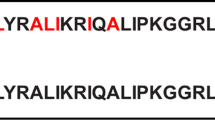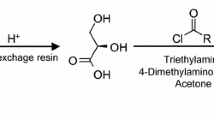Summary
A tentative structure and composition of a surfactant, BL-86, produced byBacillus licheniformis 86 is described. The surfactant is a mixture of lipopeptides with the major components ranging in size from 979 to 1091 Da and varying in increments of 14 Da. The variation in molecular weight represents changes in the number of methylene groups in the lipid and/or peptide portion of the surfactant. There are 7 amino acids per molecule. The peptide portion is composed of the following amino acids: glutamic acid or glutamine (glx), aspartic acid or asparagine (asx), valine, leucine, and isoleucine at a ratio of 1.0∶1.0∶1.4∶3.0∶0.6, respectively. The leucine is present as both thed andl isomers at a ratio of about 2∶1, respectively. Forty percent of the molecules containl-valine instead ofl-isoleucine. The glx and asx are present as a combination ofl-glutamic acid andl-asparagine and/orl-glutamine andl-aspartic acid. The N-terminus of the peptide is blocked, most likely by a peptide bond to the lipid portion. An ester carbonyl structure is present, which could be a part of a lactone ring connecting the β position of the lipid to one of the carboxyl groups in the peptide. The lipid portion is composed of, on average, 8–9 methylene groups, and contains a mixture of linear and branched tails. Results of DCI-MS and FAB-MS analyses, as well as surface tension measurements, of purified BL-86 HPLC fractions support the proposed composition.
Similar content being viewed by others
References
Arima, K., A. Kakinuma, and G. Tamura. 1968. Surfactin, a crystalline peptidelipid surfactant produced byBacillus subtilis: Isolation, characterization and its inhibition of fibrin clot formation. Biochem. Biophys. Res. Commun. 31: 488–494.
Arima, K., G. Tamura, and A. Kakinuma. 1972. Surfactin. United States Patent No. 3,687,926.
Bernheimer, A.W., and L.S. Avigad. 1970. Nature and properties of a cytological agent produced byBacillus subtilis. J. Gen. Microbiol. 61: 361–369.
Cooper, D.G., C.R. MacDonald, S.J.B. Duff, and N. Kosaric. 1981. Enhanced production of surfactin fromBacillus subtilis by continuous product removal and metal cation additions. Appl. Environ. Microbiol. 42: 408–412.
Horowitz, S., J.N. Gilbert, and W.M. Griffin. 1990. Isolation and characterization of a surfactant produced byBacillus licheniformis 86. J. Ind. Microbiol., In Press.
Hosono, K. and H. Suzuki. 1983. Acylpeptides, the inhibitors of cyclic adenosine 3′,5′-monophosphate phosphodiesterase I. Purification, physicochemical properties and structures of fatty acid residues. J. Antibiot. 36: 667–673.
Hosono, K. and H. Suzuki. 1983. Acylpeptides, the inhibitors of cyclic adenosine 3′,5′-monophosphate phosphodiesterase II. Amino acid sequence and location of lactone linkage. J. Antibiot. 36, 674–678.
Javaheri, M., G.E. Jenneman, M.J. McInerney, and R.M. Knapp. 1985. Anaerobic production of a biosurfactant byBacillus licheniformis JF-2. Appl. Environ. Microbiol. 50: 698–700.
Jenneman, G.E., M.J. McInerney, R.M. Knapp, J.B. Clark, J.M. Feero, D.E. Revus, and D.E. Menzie. 1983. A halotolerant, biosurfactant-producingBacillus species potentially useful for enhanced oil recovery. Dev. Ind. Microbiol. 24: 485–492.
Kakinuma, A., M. Hori, H. Sugino, I. Yoshida, M. Isono, G. Tamura, and K. Arima. 1969. Determination of the location of lactone ring in surfactin. Agr. Biol. Chem. 33: 1523–1524.
Kakinuma, A., M. Hori, M. Isono, G. Tamura, and K. Arima. 1969. Determination of amino acid sequence in surfactin, a crystalline peptide lipid surfactant produced byBacillus subtilis. Agr. Biol. Chem. 33: 971–972.
Kakinuma, A., H. Sugino, M. Isono, G. Tamura, and K. Arima. 1969. Determination of fatty acid in surfactin and elucidation of the total structure of surfactin. Agr. Biol. Chem. 33: 973–976.
Kluge, B., J. Vater, J. Salnikow, and K. Echart. 1988. Studies on the biosynthesis of surfactin, a lipopeptide antibiotic fromBacillus subtilis ATCC 21332. FEBS Lett. 231: 107–110.
Marfey, P. 1984. Determination of D-amino acids. II. Use of a reagent, 1,5-difluoro-2,4-dinitrobenzene. Carlsberg Res. Commun. 49: 591–596.
McInerney, M.J., G.E. Jenneman, R.M. Knapp, and D.E. Menzie. 1985. Biosurfactant and enhanced oil recovery. U.S. Patent No. 4,522,261.
Nakano, M.M., M.A. Marahiel, and P. Zuber. 1988. Identification of a genetic locus required for biosynthesis of the lipopeptide antibiotic surfactin inBacillus subtilis. J. Bacteriol. 170: 5662–5668.
Stahl, E. 1969. Thin Layer Chromatography, p. 745. Springer-Verlag (2nd).
Thomas, D.W., and T. Ito. 1969. The revised structure of the peptide antibiotic esperin, established by mass spectrometry. Tetrahedron 25: 1985–1990.
Vater, J. 1986. Lipopeptides, an attractive class of microbial surfactants. Prog. Colloid Polymer Sci. 72: 12–18.
Author information
Authors and Affiliations
Rights and permissions
About this article
Cite this article
Horowitz, S., Griffin, W.M. Structural analysis ofBacillus licheniformis 86 surfactant. Journal of Industrial Microbiology 7, 45–52 (1991). https://doi.org/10.1007/BF01575602
Received:
Revised:
Accepted:
Issue Date:
DOI: https://doi.org/10.1007/BF01575602




